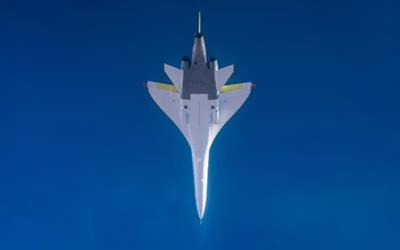Sun, May 18, 2025
Seeking Legalization Of Flight Over Land, Outlawed Since 1973
Senators Ted Budd and Thom Tillis from North Carolina, Utah’s Mike Lee, and Tim Sheehy of Montana were joined by Representatives Sharice Davids of Kansas and Troy Nehls of Texas in introducing bills in their respective chambers to legalize supersonic flight over land, which has been outlawed since 1973 due to the effects of the sonic booms.

In the Senate, S.1759, the Supersonic Aviation Modernization Act or SAM, would enable the operation of civilian supersonic flights within U.S. airspace under certain conditions. Sen. Budd says the regulations should focus on limiting the sound impact of supersonic flight rather than the speed of aircraft.
The reason supersonic flight was restricted was the impact of sonic booms over populated areas. However, recent advancements in mitigating those effects have been the subject of research done by Boom Supersonic, developers of a modern supersonic airliner.
Their aircraft, known as the Overture, is intended to be the next generation of supersonic airliners to significantly shorten travel times.
In January of this year, Boom’s prototype called XB-1, a 1/3 scale demo version of its intended Overture airliner, exceeded the sound barrier in multiple attempts. The company also tested several iterations of mitigating and even eliminating the effect of the sonic boom caused by supersonic flight through technology it calls “boomless” flight.

Boomless flight takes advantage of a phenomenon that causes the boom to reflect off a layer of temperature difference in the atmosphere when the aircraft is flying at certain altitudes and speeds. Sensitive measuring equipment on the ground under the flight path was unable to detect the sonic boom when XB-1 traversed the transonic region of speed between Mach 0.98 and Mach 1.2.
The bills in both chambers will have to be approved out of the appropriate committees and then be debated by the full chamber. If approved in one chamber, the other would also have to approve it before it is sent to the president for his signature.
More News
From 2021: The Inside Skinny On What Being An ANN Oshkosh Stringer Is All About By ANN Senior Stringer Extraordinare, Gene Yarbrough The annual gathering at Oshkosh is a right of p>[...]
Video Showed That During The Takeoff, The Nose Baggage Door Was Open On May 10, 2025, about 0935 eastern daylight time, a Piper PA-32RT-300, N30689, was destroyed when it was invol>[...]
Get The Latest in Aviation News NOW on Instagram Are you on Instagram yet? It's been around for a few years, quietly picking up traction mostly thanks to everybody's new obsession >[...]
"I think what is key, we have offered a bonus to air traffic controllers who are eligible to retire. We are going to pay them a 20% bonus on their salary to stay longer. Don't reti>[...]
Aero Linx: Pilot Briefing The gathering, translation, interpretation, and summarization of weather and aeronautical information into a form usable by the pilot or flight supervisor>[...]
 Oshkosh Memories: An Aero-News Stringer Perspective
Oshkosh Memories: An Aero-News Stringer Perspective NTSB Prelim: Piper PA32RT
NTSB Prelim: Piper PA32RT ANN FAQ: Follow Us On Instagram!
ANN FAQ: Follow Us On Instagram! Aero-News: Quote of the Day (05.28.25)
Aero-News: Quote of the Day (05.28.25) ANN's Daily Aero-Term (05.28.25): Pilot Briefing
ANN's Daily Aero-Term (05.28.25): Pilot Briefing




